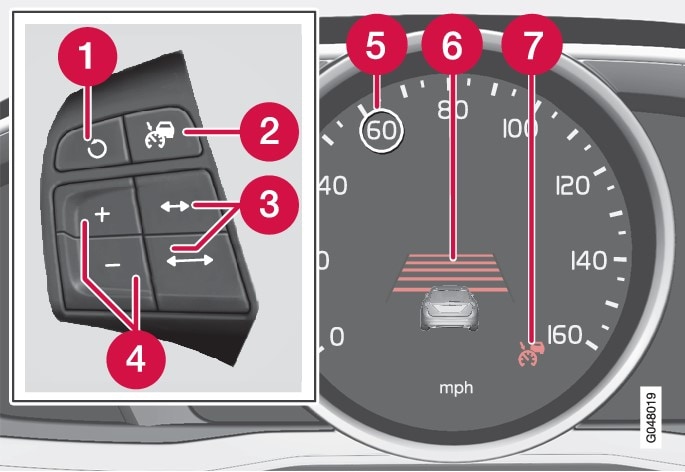When the driver has set the desired speed and the time interval to the vehicle ahead, ACC functions as follows:
- If there are no other vehicles in the lane ahead of you, your vehicle will travel at the set speed.
- If ACC's radar sensor detects a slower moving vehicle in the lane ahead, the system will adapt your vehicle's speed to help maintain the set time interval to the vehicle ahead. When there are no longer slower moving vehicles ahead, your vehicle will accelerate to resume the set speed.
If ACC is switched off completely or in standby mode and your vehicle comes too close to another vehicle ahead, the driver will be warned by the Distance Alert system (see Distance Alert – introduction).
Warning
- Adaptive Cruise Control cannot cover all driving situations and traffic, weather and road conditions. The "Function" section provides information about limitations that the driver must be aware of before using this feature.
- This system is designed to be a supplementary driving aid. It is not, however, intended to replace the driver's attention and judgement. The driver is responsible for maintaining a safe distance and speed and must intervene if Adaptive Cruise Control does not maintain a suitable speed or suitable distance to the vehicle ahead.
- Maintenance of ACC components may only be performed by a trained and qualified Volvo technician.
Operation

 Resume previous settings.
Resume previous settings. Off/On/Standby mode
Off/On/Standby mode Decrease/increase time interval
Decrease/increase time interval Put in active mode and set a speed (each additional press increases/decreases speed by 1 mph (approximately 2 km/h))
Put in active mode and set a speed (each additional press increases/decreases speed by 1 mph (approximately 2 km/h)) Set speed (shown in green when active, shown in white when in standby mode)
Set speed (shown in green when active, shown in white when in standby mode) Time interval
Time interval ACC active (green symbol) or in standby mode (white symbol)
ACC active (green symbol) or in standby mode (white symbol)
Radar sensor type approval
USA
FCC ID: L2C0038TR
Canada
IC: 3432A-0038TR
This device complies with Part 15 of the FCC Rules and with Industry Canada license-exempt RSS standard(s). Operation is subject to the following two conditions: (1) This device may not cause harmful interference, and (2) This device must accept any interference received, including interference that may cause undesired operation.
The term “IC:” before the radio certification number only signifies that Industry Canada technical specifications were met.